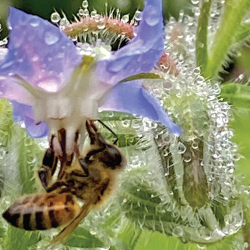Trees and home gardens are good for our mental health as well as the health of our bodies and the environment. Monoculture grass lawns on the other hand, traditional status symbols, are artificial, environmentally destructive, and merely cosmetic. Urban areas (69 million acres) make up 3.6 percent of the U.S. land area (of the Lower 48 states) but include 81 percent of the population (19 percent of people live in rural areas). Urban areas are growing by a million acres a year. Lawn areas in US cities and towns are estimated to include forty million acres of turf grass, covering 1.9 percent of the land.
In my book, Grassroots Rising I point out that that, extrapolating from recent scientific research on the potential for global reforestation (1.2 trillion trees, added to our current global stock of three trillion trees would be able to sequester a full 10 years of current emissions), we could and should be planting 500 million new trees in U.S. urban and greater urban areas over the next decade, in addition to reforesting the 254 million acres of rural (non-crop) lands that are degraded or treeless. Many of our new urban and suburban trees could and should be fruit or nut trees, providing not just shade and greenery, and habitat for birds and pollinators, but food as well.
But we need backyard (and front yard) vegetable, herb, and pollinator gardens on our 40 million acres of lawn as well, replacing our pesticide, fertilizer, and water-intensive monocultures of lawn grass.
As noted economist Ellen Brown writes:
“A confluence of crises—lockdowns and business closures, mandates and worker shortages, supply chain disruptions and inflation, sanctions and war—have compounded to trigger food shortages; and we have been warned that they may last longer than the food stored in our pantries. What to do?
Jim Gale, founder of Food Forest Abundance, pointed out in a recent interview with Del Bigtree that in the United States there are 40 million acres of lawn. Lawns are the most destructive monoculture on the planet, absorbing more resources and pesticides than any other crop, without providing any yield. If we were to turn 30% of that lawn into permaculture-based food gardens, says Gale, we could be food self-sufficient without relying on imports or chemicals…
Russian families have shown the possibilities, using permaculture methods on simple cottage gardens or allotments called dachas. As Dr. Leon Sharashkin, a Russian translator and editor with a PhD in forestry from the University of Missouri, explains:
“Essentially, what Russian gardeners do is demonstrate that gardeners can feed the world – and you do not need any GMOs, industrial farms, or any other technological gimmicks to guarantee everybody’s got enough food to eat. Bear in mind that Russia only has 110 days of growing season per year – so in the US, for example, gardeners’ output could be substantially greater. Today, however, the area taken up by lawns in the US is two times greater than that of Russia’s gardens – and it produces nothing but a multi-billion-dollar lawn care industry.”
Russian dachas or home gardens, usually located on the perimeter of urban areas, produce approximately 50% of families’ food on three percent of the land. During the Second World War U.S. (and UK) backyard “Victory Gardens” did the same.”
Learn more: Ellen Brown: The Food Shortage Solution in Your Own Backyard

